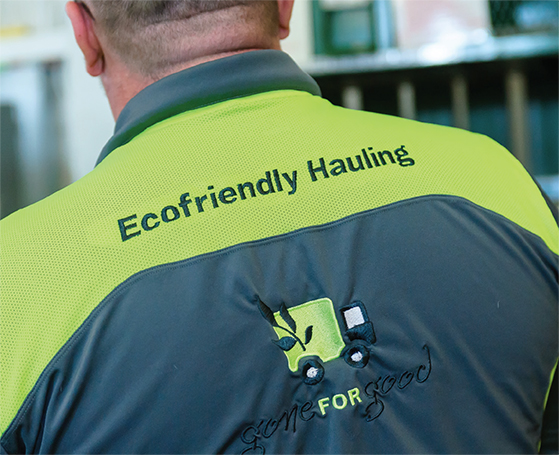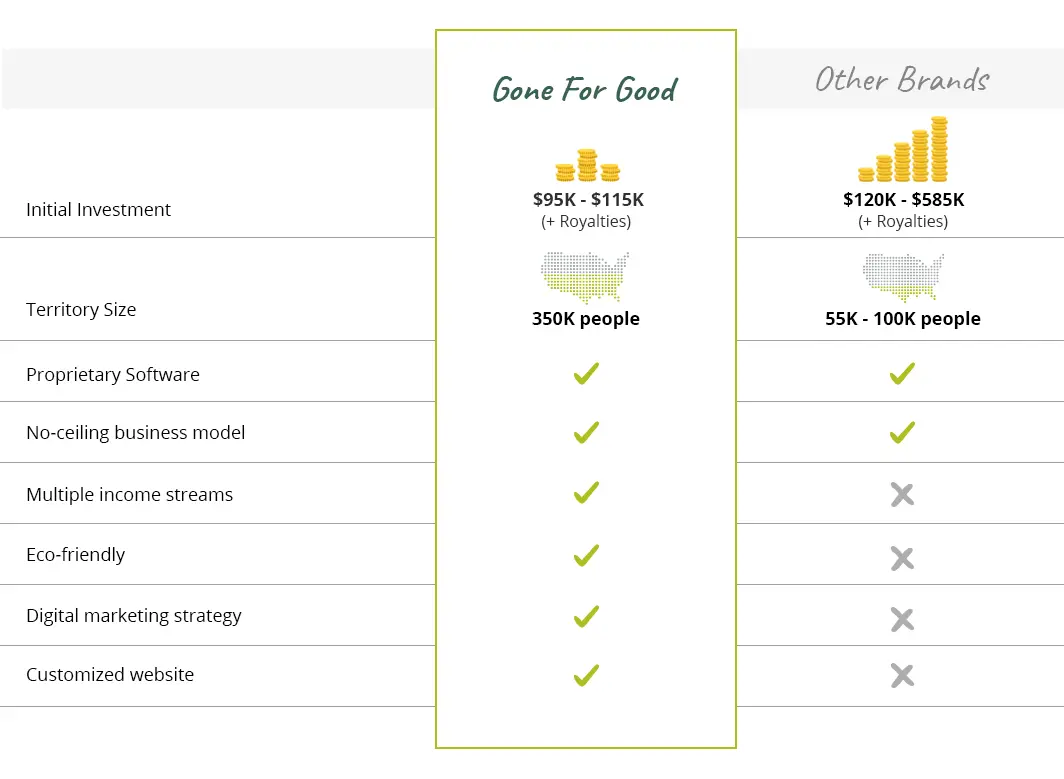Own your own eco-friendly junk hauling and recycling business. This is your chance to dive in to a growing industry and own a business that generates multiple income streams, does good things for the environment and our local communities and sets you on the path to achieving your financial goals. Gone For Good® has open franchise opportunities throughout Colorado.
If you’re ready to own your own business and take control of your future, we’d love to talk to you.
Please fill out the form below for more info.
How Gone For Good was born
One Saturday morning, I was eating breakfast and knew that I was going to have a rough weekend. It was time to do some Spring cleaning! Ughhhhh! After a nice breakfast I had the courage to go down to the basement and see the monster that was slowly taking over my house. What a mess! My first thought. No problem, I can order a rolloff dumpster and be done with this mess in one day. No! That’s not right. I can’t throw my son’s favorite car bed into the dumpster. Let’s do this the right way and keep stuff out of the landfill.
So I went to the computer and looked for a service that would take my stuff and keep it out of the landfill. It turns out that there really wasn’t a one stop service. I realized I would have to take my TV to one location; my donations I would need to be hauled out of the basement and put out on the curb; and all the recycle items would have to be dropped off at two different locations. What a hassle. This is going to take some time. Boom– then it then popped in my head. People need this service. Nobody has the time or energy to go through all the steps needed to keep junk out of the landfill.
So I created Gone for Good, and it would reflect my personal mission to Reduce, Resell, and Recycle. Gone for Good would be Good for people using the service, Good for the community, and Good for the environment.
Finding new homes or new purposes for used and unwanted items is what inspired owner-operator Reid Husmer, to create Gone For Good®. The double entendre behind the name means that items are gone for good (permanently) from homeowner’s or business owner’s perspective and they are gone for good in terms of going to good causes. Since its founding in 2008, the need and the demand to responsibly dispose of everyday items has increased exponentially.
Reid designed the business model to maximize success in each community. By forming valuable relationships with local organizations in order to discover their needs – such as clothing for women, children and the homeless, Gone For Good® then fulfills those needs by donating items they have collected to specific local and international charities and organizations.
Reid imagines and works toward a day when contributions to needy people and organizations are no longer hindered by cost. Helping people and helping the environment are driving forces at Gone For Good® and have become the reason behind Reid’s decision to begin franchising. If you share Reid’s passion for green initiatives and for giving to others, Gone For Good® has a very exciting opportunity for you!
Denver Housing Authority • Project Cure • Free the Girls Operation Gratitude • RAFT • Soles 4 Souls • A Precious Child • Metro Caring Open Door Ministries • Hope House • Denver Rescue Mission

We strive to give our customers a hassle free experience for all of their hauling, junk, and waste removal needs.
 When it comes to leading the world in green living, America has a lot of obstacles to overcome. For the average citizen, some of the most common green challenges include:
When it comes to leading the world in green living, America has a lot of obstacles to overcome. For the average citizen, some of the most common green challenges include:
In Europe, citizens pay additional taxes and upfront fees at the time of purchase to help pay for the costs associated with an item’s responsible disposal. Europeans also return packaging and containers to sellers and they ensure the proper break-down of disposable items. Even on the front end, bags that would make the carrying of purchases much easier are a no-no. In fact, most stores in Europe charge a fine of some sort to customers who purchase bags in addition to their merchandise.
Until America graduates to this kind of thinking where we think about the complete life cycle of everything we buy and consume, there’s Gone For Good. Ruth Cuevas recently put it best in her Elephant Journal article entitled “No Wonder Recycling in the United States is so far behind Europe.” In this article from April 20, 2018, she stated,
“The key is pragmatic, conscious living rather than a focus on sheer convenience.”
Gone For Good leads the way in the proper disposal of just about any item in any home or business. We come with our trucks, haulers, and knowledge to take from homeowners and business owners what they no longer want and ensure it is disposed of properly. Sometimes that means recycling. Sometimes that means donating to worthy causes or repurposing. And sometimes, it even means reselling through a storefront retail location.
Consciousness and convenience collide!
| Type of Expenditure | Amount | Method of Payment | When Due | To Whom Payment is to be Made |
|---|---|---|---|---|
| Initial Franchise Fee: | $40,000 | Lump sum | At signing of Franchise Agreement | Us |
| Building and Tenant Improvements: | $500 - $3,000 | As incurred | Before opening | Other suppliers |
| Uniforms, Equipment, Furnishings and Electronics | $4,595 - $7,000 | As incurred | Before opening | Other suppliers |
| Signs | $2,300 - $6,000 | As incurred | Before opening | Other suppliers |
| Point-of-Sale System, Software and Office Equipment | $2,000 - $5,000 | As incurred | Before opening | Other suppliers |
| Tech Setup Fee | $1000 | Lump sum | 60 days after signing Franchise Agreement | Us |
| Security Deposits, Utility Deposits, Business Licenses, Insurance | $14,510 - $18,000 | As incurred | Before opening | Other suppliers |
| Initial Training: Travel and Living Expenses | $500 - $2,000 | As incurred | Before opening | Other suppliers |
| Additional Funds- 3 months | $15,000 - $20,000 | As incurred | As incurred | Other suppliers |
| TOTAL ESTIMATED INITIAL INVESTMENT | $95,000 to $115,000 | |||
103,718 sq mi (268,875 km2)
Territory available
5,770,545
Total Population
≈8 million tons
Amount of Trash Produced Each Year in Colorado
Colorado
2,319,737
Total Households
$ 65,458
Median Household Income
David was the first franchisee of Gone For Good®. "With a successful track record of 9 years in the industry, we have been able to come up with new ideas and approaches to enhance our services and customer experience," comments David.
